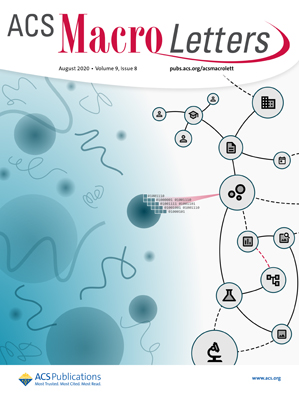Bulk Depolymerization of Polystyrene with Comonomer Radical Triggers
IF 5.1
Q1 POLYMER SCIENCE
引用次数: 0
Abstract
This study introduces a novel approach to depolymerize polystyrene in the absence of solvent at significantly reduced temperatures through the incorporation of a thermally labile comonomer. Specifically, we employ N-(methacryloxy)phthalimide (PhthMA) as a comonomer with an activated ester capable of thermally triggered decarboxylation. Thermal treatment enables the generation of backbone radicals that promote β-scission and subsequent unzipping. These polystyrene analogs depolymerize with up to 91% reversion to monomer in under 2 h at temperatures significantly lower than those required for conventional polystyrene. As compared to depolymerization triggered by decarboxylation at the ω-chain end, this pendent-group approach was considerably more efficient. The recovered styrene monomer from the bulk depolymerization of poly(styrene-co-PhthMA) copolymers can undergo direct repolymerization, yielding new styrenic materials. This comonomer strategy extends across various styrenic copolymers, highlighting its potential as a broadly applicable method for initiating depolymerization among vinyl polymer classes.

共聚单体自由基引发聚苯乙烯本体解聚的研究
本研究介绍了一种在没有溶剂的情况下,通过加入热不稳定的共聚单体,在显著降低的温度下解聚聚苯乙烯的新方法。具体来说,我们采用N-(甲基丙烯氧基)邻苯二胺(PhthMA)作为共聚单体,具有能够热触发脱羧的活性酯。热处理使骨干自由基的产生,促进β-断裂和随后的解压缩。这些聚苯乙烯类似物在明显低于常规聚苯乙烯所需的温度下,在2小时内以高达91%的还原率解聚为单体。与ω链端脱羧引发的解聚相比,这种悬垂基团的方法效率要高得多。聚苯乙烯-共聚苯乙烯共聚物本体解聚回收的苯乙烯单体可以进行直接再聚合,生成新的苯乙烯材料。这种共聚物策略扩展到各种苯乙烯共聚物,突出了它作为一种广泛适用的方法来引发乙烯基聚合物类之间的解聚的潜力。
本文章由计算机程序翻译,如有差异,请以英文原文为准。
求助全文
约1分钟内获得全文
求助全文
来源期刊
CiteScore
10.40
自引率
3.40%
发文量
209
审稿时长
1 months
期刊介绍:
ACS Macro Letters publishes research in all areas of contemporary soft matter science in which macromolecules play a key role, including nanotechnology, self-assembly, supramolecular chemistry, biomaterials, energy generation and storage, and renewable/sustainable materials. Submissions to ACS Macro Letters should justify clearly the rapid disclosure of the key elements of the study. The scope of the journal includes high-impact research of broad interest in all areas of polymer science and engineering, including cross-disciplinary research that interfaces with polymer science.
With the launch of ACS Macro Letters, all Communications that were formerly published in Macromolecules and Biomacromolecules will be published as Letters in ACS Macro Letters.

 求助内容:
求助内容: 应助结果提醒方式:
应助结果提醒方式:


